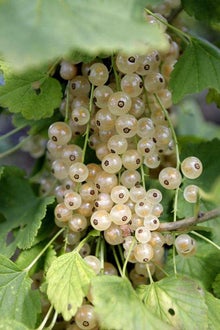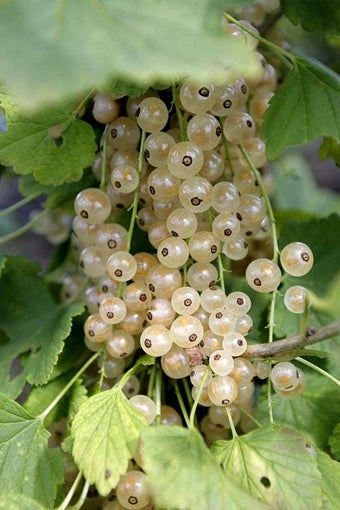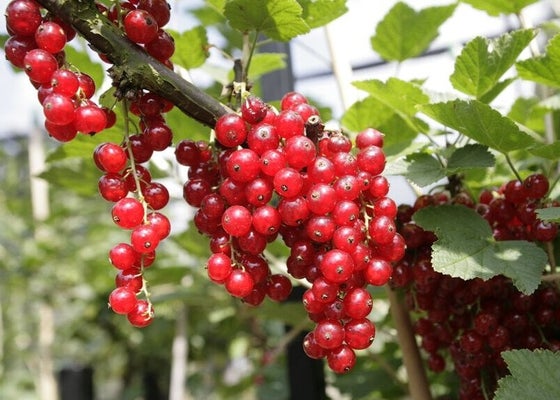
Quick facts
Usually trained as an open-centred bush
If space is limited, train as a cordon or fan against a support
Standard-trained plants make attractive features
Prune bushes in winter, and cordons and fans in summer too
Before you start
While training and pruning isn’t essential, it does help to maximise cropping and keep plants productive and well shaped, making good use of available space. Pruning should be started as soon as they are planted and carried out once or twice a year, depending on which shape you choose.
The most fruitful training option is a multi-stemmed, open-centred bush, with eight to ten main branches radiating from a short trunk (leg).
Where space is limited or to make the most of an east- or north-facing wall or fence, both of these currants can be trained as single- or multi-stemmed cordons. The fruit is produced on short side-shoots growing from a vertical stem(s). Another compact option is a fan, trainedagainst a wall or fence.
Standard-trained currants also take up little space and make an attractive feature, ideal in borders, kitchen gardens and formal parterres, or planted in containers.
Fruiting
The flower form at the base of the shoots that grew the previous year and on spurs (short shoots) on older wood. The main branches will remain productive for a number of years.
of inconspicuous yellow-green, self-fertile flowers are produced in spring. The fruits are highly ornamental – vibrant, glossy red or pearly white – and hang in long clusters.
What to buy
To grow as a bush, buy a one- or two-year-old plant with a short main stem (leg) that is 10–15m (4–6in) long, and three or more strongly growing side-shoots. These are widely available container-grown, or can be bought as plants from online suppliers between autumn and early spring.
For training, buy a one-year-old cutting or pre-trained cordon, available from specialist fruit suppliers. It’s also possible to convert a one- or two-year-old bush-trained plant – select one strong, upright stem and prune the rest back to 2.5cm (1in).
To train a fan, buy a one-year-old cutting or a plant sold for cordon training. Prune after planting, cutting the main stem down to 15cm (6in) from the ground. You may also be able to convert a bush-trained plant – select two to four suitably positioned stems that can be trained flat against a support and reduce their height by half to encourage further branching. Remove any other stems.
For growing as a standard, buy a pre-trained, grafted or budded plant with a single clear stem (trunk) 1–1.2m (3½–4ft) tall, topped with a bushy ‘head’ of branches. These are generally only available from specialist suppliers. To keep the shape, the branches need to be pruned in the same way as bush-trained plants.
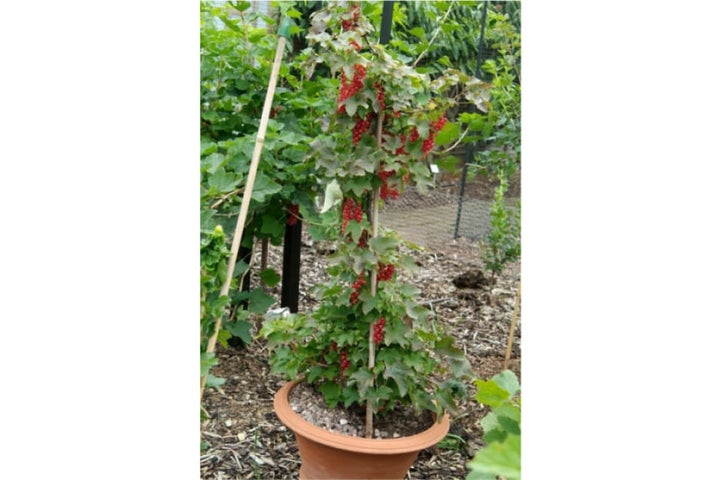
For more on growing these currants, see our guides:
When to prune
- From late winter to early spring – prune all forms of red- and whitecurrants annually, while the plants are still , before any signs of growth appear
- In mid-summer – prune cordons and fans to restrict growth and maintain their shape. Additionally, vigorous cultivars trained as bushes can be pruned to curb their growth
Bushes – initial pruning and training
The aim of initial pruning is to create an open-centred, goblet-shaped bush with eight to ten main branches radiating from a short stem (leg). When pruning, make your cut above an outward-facing , unless the branch is growing at a wide angle close to horizontal, in which case you should prune above an upward-facing bud.
If planting more than one bush, space them 1.5–1.8m (5–6ft) apart.
Year 1 – pruning after planting
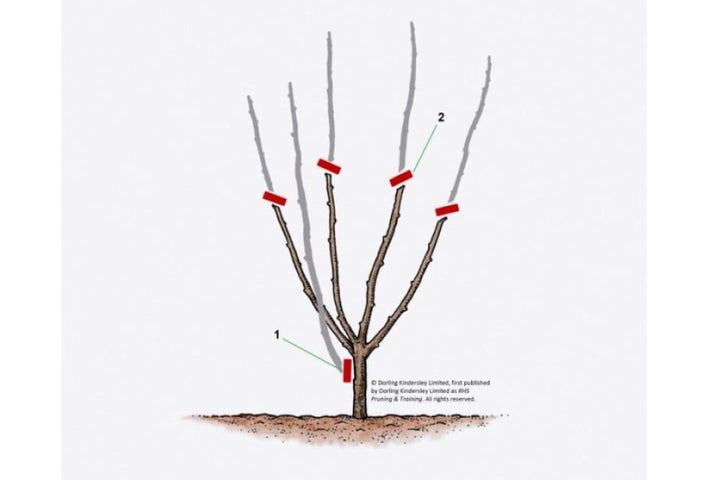
- Remove any shoots growing from the short main stem to keep it clear
- Select up to five well-spaced, strong shoots and prune them back to 15–20cm (6–8in). Remove any other shoots
Year 2 – late winter

Continue to build up the framework of main branches, aiming for eight to ten in total, in a goblet shape with an open centre.
- Shorten by half last year’s growth on the original branches pruned the previous year
- Select another five or six well-placed, strongly growing, outward-facing shoots that will form the additional main branches. Prune them back by half
- With any surplus or badly positioned shoots (for example that are crossing or growing inwards to the centre), prune them back to one outward-facing bud
Bushes – pruning and training established plants
Winter pruning
This should be carried out every year while the plant is , to maintain the open-centred bush shape, with up to ten well-spaced main branches carrying short side-shoots. This will enhance fruit ripening, as well as making harvesting easier. Keeping an open centre ensures the branches don’t become overcrowded and more prone to pests and diseases.
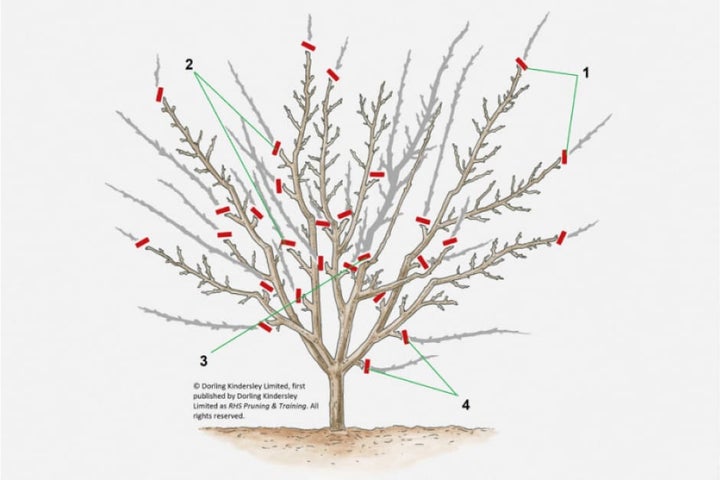
Start by removing any dead or damaged shoots, then:
- Reduce the previous season’s growth on the main branches by a quarter to a half
- Prune back shoots growing from the main branches or previously pruned side-shoots to one to two , but retain shoots that can be used as replacement branches (see below)
- On mature bushes, remove one or two older, less-fruitful branches either every year or every other year to stimulate the production of strong replacements. Alternatively, prune to an existing strong side-shoot that can become a replacement
- Remove any low-growing branches that will bend even lower under the weight of the crop. This helps to avoid soil splash on the fruit and reduce pest damage
Summer pruning
Summer pruning isn’t essential, but can be carried out on more vigorous cultivars to curb their growth. In mid-June to July, shorten the current season’s growth on side-shoots growing from the main branches, cutting them back to five leaves. But avoid pruning any shoots that are needed to replace old, less fruitful branches.
Standards – pruning and training
A ‘standard’ is a form of training that produces a lollipop-shaped plant, with a straight bare trunk and a ‘head’ of branches at the top.
The branches need to be pruned in the same way as a bush (see above), to form an open-centred goblet shape. Regular pruning is essential to prevent the head becoming too large and overcrowded. Standards also need a permanent strong stake to support the main stem.
To form the ‘standard’ shape, the fruiting has been grafted (or budded) onto the top of the main stem, which is a different plant, usually Ribes aureum. This means that any shoots (or suckers) growing from the lower part won’t be the desired cultivar. So promptly remove any shoots that sprout from the base or the main stem below the graft point.
You may also occasionally see shoots in the crown with untypical, more gooseberry-like leaves, bearing orange-yellow fruit. This will be a Ribes aureum shoot. Trace the shoot to the point of origin and remove it entirely.
Cordons – pruning and training
A is a compact form, with one or more stems trained vertically to a permanent support.
If you’ll be growing several plants, set up a system of horizontal wires stretched between posts or fixed to a wall or fence. Space the wires 40–60cm (16–24in) apart. Then insert a 1.7m (5ft 6in) bamboo vertically to support each cordon stem, and secure it to the wires. Plant single-stemmed cordons 38–45cm (15–18in) apart along the row, using the wider spacing on good soil.
If you’re only growing a few plants, strong stakes should be sufficient support.
Single-stemmed vertical cordon
Year 1 – winter after planting
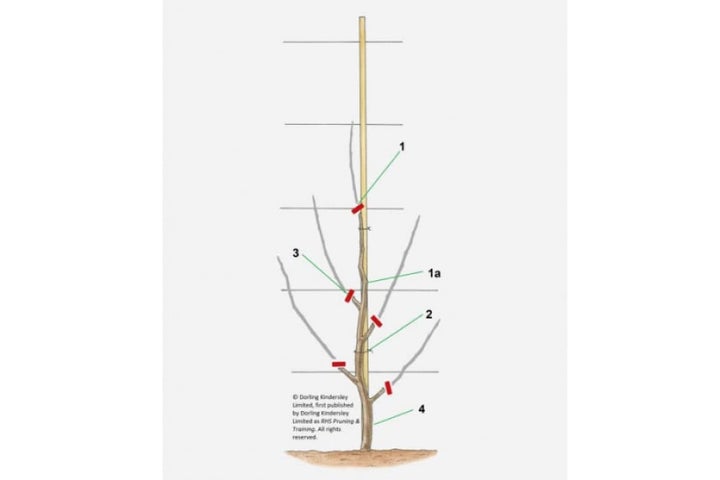
- If starting with a one-year-old plant, prune the previous season’s growth on the main (leading) shoot by a quarter to a half. Look for the top of the original cutting – marked ‘1a’
- Tie this main stem to a bamboo cane fixed to the horizontal wires
- Prune all other shoots back to one
- Keep the lower 15–20cm (6–8in) of the stem free of any shoots
Pre-trained cordons may have already been pruned before sale. If not, treat as described above.
It is also possible to convert a young one- or two-year-old bush-trained plant. Select one strong, upright shoot and reduce the previous season’s growth by a quarter to a half. Prune all other shoots back to one to two .
Year 1 - summer and onwards

- Continue tying the leading shoot to the support as it grows
- Once the side-shoots have produced seven to eight leaves, prune them back to five leaves. Pinch back any re-growth or developing side-shoots to one leaf
Year 2 - winter and onwards
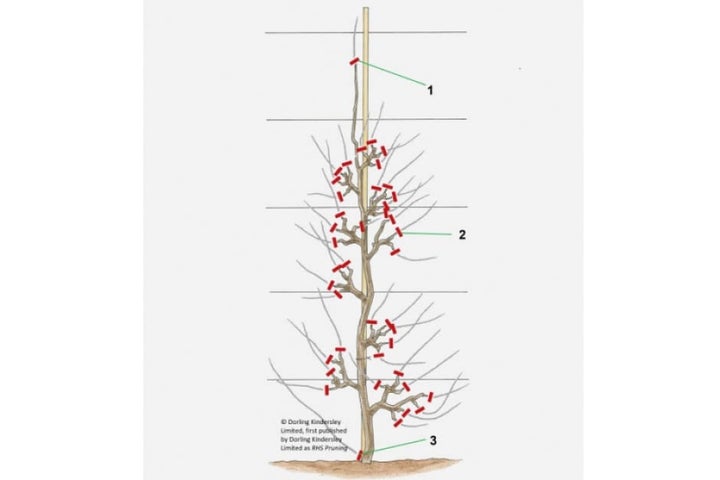
- Prune the previous season’s growth on the main vertical stem by a quarter, or by half if growth is weak. Cut just above a bud on the opposite side to the last year’s cut, to keep the growth straight. Once the cordon reaches the desired height, prune the new growth back to one bud each year
- Prune the side-shoots that were pruned in summer back to one or two buds. On more mature cordons, the spur systems (clusters of short fruiting shoots) can become overcrowded – renovate by pruning out some of the older sections
- Keep the base of the main stem free of any shoots
Follow this with summer pruning as described for Year 1– summer and onwards. Once the cordon reaches the desired height, prune the new growth on the leading shoot to five buds each time.
Double cordon
- Straight after planting in winter, select two well-placed side-shoots on the main (leading) stem that are growing almost opposite each other. They should be about 15–25cm (6–10in) from the ground
- Prune the main stem back to just above the topmost selected side-shoot
- Any shoots growing below the lower selected side-shoot should be cut back to two buds. Then remove the shoots entirely in summer – they were simply helping to support the plant’s growth
- Train the selected shoots in opposite directions at a 30° angle. Once they reach 20–25cm (8–10in) in length, start training them upwards, tying them vertically to canes
- Continue summer and winter pruning as for a single-stemmed vertical cordon


